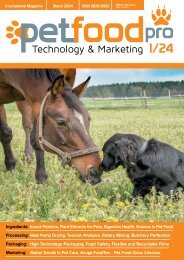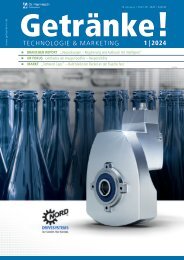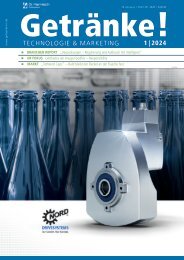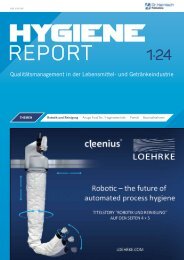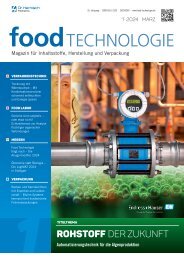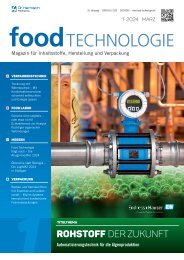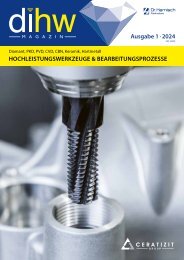Wellness Foods + Supplements 1/2022
Wellness Foods & Supplements is the first European magazine devoted exclusively to health ingredients, nutraceutical foods and beverages. Questions about the trade magazine Wellness Foods & Supplements? Interested in subscribing or advertising? The board of editors at Wellness Foods & Supplements kindly remains at your disposal.
Wellness Foods & Supplements is the first European magazine devoted exclusively to health ingredients, nutraceutical foods and beverages.
Questions about the trade magazine Wellness Foods & Supplements? Interested in subscribing or advertising? The board of editors at Wellness Foods & Supplements kindly remains at your disposal.
Create successful ePaper yourself
Turn your PDF publications into a flip-book with our unique Google optimized e-Paper software.
AMD and micronutrients<br />
affects blue-sensitive photoreceptor cells.<br />
With AMD, the perception of blue and<br />
violet is therefore the first to fail. The colour<br />
impression shifts towards grey to brown. It<br />
could be shown that low carotenoid concentrations<br />
in the macula are causally involved<br />
in the development of AMD and can predict<br />
corresponding eye damage with lead times<br />
of around 20 years. (5) The macular pigment<br />
lutein must be ingested with food because<br />
the body cannot synthesize it from other<br />
carotenoids such as β-carotene. The structurally<br />
related carotenoid zeaxanthin, on the<br />
other hand, can be synthesized from lutein<br />
if required. A recent review that evaluated<br />
data from more than 900 participants with<br />
AMD showed significant improvements in<br />
visual acuity and contrast sensitivity. Accordingly,<br />
supplementation of lutein increases<br />
the pigment content of the macula in a dosedependent<br />
manner. (6)<br />
Improving bioavailability through<br />
phospholipids<br />
Coenzyme Q10 and lutein are not soluble in<br />
water and only have a limited solubility in fats.<br />
The active ingredients tend to agglomerate<br />
in the gastrointestinal tract when supplemented<br />
in powder capsule or tablet form.<br />
As a result, only molecules on the surface<br />
of the agglomerates can be absorbed by the<br />
enterocytes of the small intestine, while the<br />
majority pass through the body unchanged.<br />
However, a significant improvement in bioavailability<br />
can be achieved by forming emulsions<br />
with natural phospholipids (lecithin), in<br />
which the active ingredients are present in<br />
small droplets coated with lecithin (Fig. 5).<br />
Lecithin is also a natural component of bile<br />
that facilitates the absorption of dietary fats<br />
and fat-soluble nutrients. A crossover study<br />
was able to show that the bioavailability of<br />
coenzyme Q10 can be improved by a factor<br />
of five with an appropriate formulation. (7)<br />
For more information, please contact<br />
Philipp Gebhardt<br />
65779 Kelkheim, Germany<br />
p.gebhardt@mitotherapie.de<br />
Conclusion<br />
7<br />
2<br />
1<br />
Fig. 5: Improvement of the bioavailability of<br />
coenzyme Q10 by formulation with lecithin: Coenzyme<br />
Q10 is packaged in ultra-small droplets<br />
with natural phospholipids [1]. The absorption<br />
of the coenzyme begins in the mouth via the oral<br />
mucosa [2]. The lecithin shell protects the active<br />
ingredients from the harsh environment of the<br />
stomach [3]. Lecithin is a natural component of<br />
bile that facilitates the digestion of dietary fats<br />
and fat-soluble nutrients [4]. The prepackaged<br />
coenzyme Q10 can be absorbed much better<br />
by the enterocytes of the small intestine [5]. In<br />
the enterocytes, fat-soluble nutrients are packed<br />
into chylomicrons or lipoproteins with the help<br />
of phospholipids [6]. For systemic distribution,<br />
the coenzyme Q10-containing chylomicrons are<br />
released into the lymph and the coenzyme Q10-<br />
containing lipoproteins into the blood [7].<br />
The development of age-related macular<br />
degeneration is promoted by a low carotenoid<br />
content in the macula. The carotenoid lutein<br />
can improve the eye’s natural sun protection<br />
and thus reduce the harmful effects of light<br />
and the light-induced formation of oxygen<br />
radicals. Antioxidants such as coenzyme<br />
Q10 can increase the neutralization capacity<br />
for oxygen radicals and help to protect the<br />
eyes. In addition to its antioxidant effect,<br />
coenzyme Q10 is characterized by the fact<br />
that it improves the function of the respiratory<br />
chain and contributes to energy production.<br />
In addition to a low intake of lutein with<br />
food, smoking and high blood pressure are<br />
considered risk factors for AMD. (8) In addition,<br />
increased concentrations of the toxic<br />
metabolic intermediate homocysteine and<br />
reduced vitamin B12 levels have also been<br />
identified as risk factors. (9)<br />
3<br />
Enterozyte<br />
6<br />
5<br />
4<br />
References<br />
(1) Brandl, C., Stark, K. J., Wintergerst, M., Heinemann,<br />
M., Heid, I. M., & Finger, R. P. (2016). Epidemiologie der<br />
altersbedingten Makuladegeneration. Der Ophthalmologe,<br />
113(9), 735-745.<br />
(2) Suter, M., Remé, C., Grimm, C., Wenzel, A., Jättela, M.,<br />
Esser, P., ... & Richter, C. (2000). Age-related macular<br />
degeneration the lipofuscin componentn-retinyl-n-retinylidene<br />
ethanolamine detaches proapoptotic proteins<br />
from mitochondria and induces apoptosis in mammalian<br />
retinal pigment epithelial cells. Journal of Biological<br />
Chemistry, 275(50), 39625-39630.<br />
(3) Feher, J., Kovacs, B., Kovacs, I., Schveoller, M., Papale,<br />
A., & Gabrieli, C. B. (2005). Improvement of visual functions<br />
and fundus alterations in early age-related macular<br />
degeneration treated with a combination of acetyl-L-carnitine,<br />
n-3 fatty acids, and coenzyme Q10. Ophthalmologica,<br />
219(3), 154-166.<br />
(4) Arnold, C., Winter, L., Fröhlich, K., Jentsch, S.,<br />
Daw czynski, J., Jahreis, G., & Böhm, V. (2013). Macular<br />
xanthophylls and ω-3 long-chain polyunsaturated fatty<br />
acids in age-related macular degeneration: a randomized<br />
trial. JAMA ophthalmology, 131(5), 564-572.<br />
(5) Arunkumar, R., Calvo, C. M., Conrady, C. D., & Bernstein,<br />
P. S. (2018). What do we know about the macular<br />
pigment in AMD: the past, the present, and the future.<br />
Eye, 32(5), 992-1004.<br />
(6) Feng, L., Nie, K., Jiang, H., & Fan, W. (2019). Effects of<br />
lutein supplementation in age-related macular degeneration.<br />
PloS one, 14(12).<br />
(7) Wajda, R., Zirkel, J., & Schaffer, T. (2007). Increase of<br />
bioavailability of coenzyme Q10 and vitamin E. Journal of<br />
medicinal food, 10(4), 731-734.<br />
(8) Hyman, L., & Neborsky, R. (2002). Risk factors for agerelated<br />
macular degeneration: an update. Current opinion<br />
in ophthalmology, 13(3), 171-175.<br />
(9) Rochtchina, E., Wang, J. J., Flood, V. M., & Mitchell, P.<br />
(2007). Elevated serum homocysteine, low serum vitamin<br />
B12, folate, and age-related macular degeneration: the<br />
Blue Mountains Eye Study. American journal of ophthalmology,<br />
143(2), 344-346.<br />
30 No. 1 April/May <strong>2022</strong>











